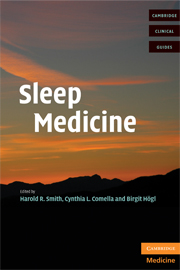Book contents
- Frontmatter
- Contents
- List of contributors
- Foreword
- SECTION 1 NORMAL SLEEP
- SECTION 2 SLEEP DISORDERS
- 3 Parasomnias
- 4 Circadian rhythm disorders
- 5 Excessive somnolence disorders
- 6 Insomnias
- 7 Restless legs syndrome and periodic limb movement disorder
- 8 Sleep apnea (central and obstructive)
- SECTION 3 SLEEP IN SPECIALTY AREAS
- Index
- References
4 - Circadian rhythm disorders
from SECTION 2 - SLEEP DISORDERS
Published online by Cambridge University Press: 08 August 2009
- Frontmatter
- Contents
- List of contributors
- Foreword
- SECTION 1 NORMAL SLEEP
- SECTION 2 SLEEP DISORDERS
- 3 Parasomnias
- 4 Circadian rhythm disorders
- 5 Excessive somnolence disorders
- 6 Insomnias
- 7 Restless legs syndrome and periodic limb movement disorder
- 8 Sleep apnea (central and obstructive)
- SECTION 3 SLEEP IN SPECIALTY AREAS
- Index
- References
Summary
Introduction
Circadian rhythms are physiologic or behavioral cycles which are generated by an internal pacemaker with an oscillatory frequency of approximately 24 hours. The most conspicuous function of circadian rhythms which have evolved in humans is the control of the sleep/wake cycle, with wakefulness commonly promoted during daylight hours and sleep promoted during evening hours. When abnormalities in the phase relationship between the endogenous circadian system and the exogenous light/dark cycle occur, circadian rhythm sleep disorders may ensue. Circadian rhythm sleep disorders are thus defined by this desynchronization and result in a sleep/wake schedule at odds with societal norms or work schedules, with consequent symptoms of excessive daytime sleepiness, insomnia, or an impairment of social, occupational, or academic functioning.
Six currently recognized circadian rhythm sleep disorders exist. The delayed sleep phase type, the advanced sleep phase type, the non-24-hour sleep/wake syndrome, and the irregular sleep/wake rhythm all entail a primary abnormality of an individual's circadian system. The other two circadian rhythm sleep disorders, shift work sleep disorder and jet lag disorder, involve an alteration in the light/dark or social-activity cycles of the surrounding environment which conflicts with the individual's intrinsic circadian timing. Considerable advances in the understanding of the genetic, physiologic, and anatomic basis of circadian rhythms have led to new insights into the pathophysiology of these disorders. This chapter will discuss circadian rhythms and the known factors which influence them as well as provide an update on the evaluation and treatments of the six circadian rhythm sleep disorders.
Keywords
- Type
- Chapter
- Information
- Sleep Medicine , pp. 56 - 77Publisher: Cambridge University PressPrint publication year: 2008
References
- 2
- Cited by



